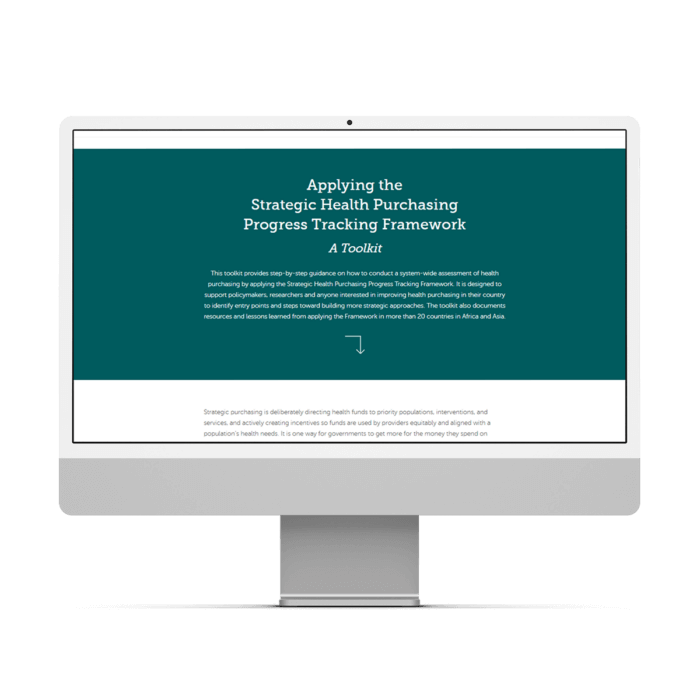Exploring a new toolkit to better describe and understand health purchasing
Fiscal space is limited in many countries, and recent analysis shows declining trends in public resources allocated to health care post-COVID. Despite the limited fiscal space, there is recognition that countries can do more within the resources available through strategic purchasing.
Purchasing is the transfer of pooled funds to health care providers. Strategic purchasing aims to use available resources more efficiently to deliver high-quality services. It involves using evidence and information about population health needs and health provider performance to make decisions about which health services should have priority for public funding (“what to buy”), which providers will provide these services (“from whom to buy”), and how and how much providers will be paid to deliver those services (“how to buy”).
The Strategic Purchasing Progress Tracking Framework (Framework) was co-created by African health financing researchers and academics, in collaboration with Results for Development (R4D), through the Strategic Purchasing Africa Resource Center (SPARC). It builds on existing frameworks and focuses on the core purchasing functions of benefits specification, contracting arrangements, provider payment and performance monitoring. The Framework examines the governance and institutional arrangements that support the core purchasing functions, as well as factors that can either strengthen or weaken the power of purchasers to directly influence resource allocation and provider behavior.
The Framework provides a practical way to understand how resources flow through the health system — moving beyond individual schemes to understand the interactions of the different funding channels, incentives created that can alter provider behavior, and the levers to improve how resources are directed to priority populations, interventions and services.
The Framework has been used in over 20 countries in Africa and Asia through SPARC and the Southeast Asia Research Collaborative for Health (SEARCH) and is being applied by other researchers globally.
In Cameroon, for example, Isidore Sieleunou and his team implemented the Framework because policymakers recognized it as an opportunity to assess “how schemes progress over time” through a co-creative process which would “shape the conversation around the universal health coverage movement.”
To scale the use of the Framework, R4D developed a toolkit to assist other researchers and policymakers considering applying the use of the Framework in their countries. The toolkit combines the concepts of strategic purchasing espoused in the Framework with practical guidance for assessing the purchasing functions in a health system.
In the process of developing the toolkit, R4D consulted representatives from the 20 countries across Africa and Southeast Asia that applied the Framework to understand how the toolkit can be made most useful to others attempting to use it independently. R4D also used the opportunity to better clarify questions within the data collection tools that were ambiguous or challenging during the application of the Framework.
In addition to providing context and framing strategic purchasing and the relevance of the framework, this toolkit breaks down the process of applying the framework into four steps:
- Planning and preparing
- Data collection
- Data analysis and validation
- Sharing findings for decisions and actions.
The toolkit walks users through each step and provides useful tips and tools to successfully apply the framework in their country.
Each country’s health system will be unique and will have challenges that are specific to its circumstances, and the framework is designed to be adapted to these specifications.
Ryan Rachmad Nugraha, an implementer of the framework in Indonesia, expressed that while certain aspects of the framework “might resonate in a pool of countries more than others, that’s the beauty of it” because the framework can be used to address each set of unique circumstances and challenges. The toolkit helps guide users through this adaptation process, which can be especially useful when one-on-one coaching and mentoring is not available.
Throughout the toolkit, users can watch testimonials from experts who have applied the framework in their own countries. These testimonials highlight the key takeaways from their application of the framework and their advice to those applying the framework for the first time.
When describing how she and her research team applied the framework in Southeast Asia, Capucine Barcellona shared that they were able to avoid contradicting themselves because they “were just reporting on the facts from a neutral perspective.” This insight is very relevant for many users of the framework who may be closely involved with the health system, to remain objective and neutral as they describe and report their findings.
Video animations simplify the four steps and serve as a tutorial throughout the application of the framework. The testimonials and animations address some of the common questions that users may have during this process, including
- How to set up a research team
- How to include policymakers in the process
- How to organize and analyze findings
- How to reach consensus on thorny or controversial aspects of purchasing
The goal of using the Framework is to ultimately inform policy decisions that will improve how resources are allocated, and this toolkit facilitates users as they apply the Framework to respond to pertinent questions raised by policymakers to improve purchasing, with tips and advice from other experienced users and experts.
The toolkit incorporates some of the best elements of R4D’s Collaborative Learning and Coaching approaches — learning from peers, learning by doing and facilitating technical conversations through country-led processes. The toolkit is not meant to be a static output, and we encourage you to share your feedback, lessons and comments as we iterate and improve the tool to make it useful for decision making as countries make progress toward universal health coverage.














